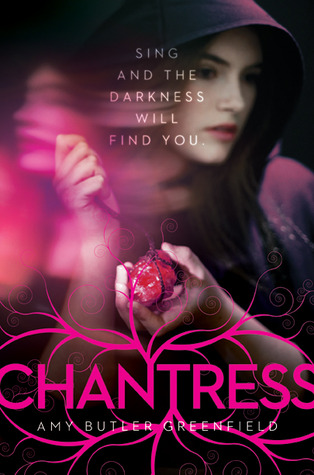
Margaret K. McElderry Books, May 7 2013
young adult historical fantasy
digital review copy received via Edelweiss
Summary:
Lucy never expected that taking off the stone pendant she’s always worn would cause her world to burst into song. And when she sings the song, it wraps her up, sweeps her off her feet and spirits her and her guardian, Norrie, away from their isolated island and into the midst of London. There, she learns that a man named Scargrave has seized control over the King through a grimoire—a grimoire taken from a Chantress. And Lucy learns that as a Chantress herself, it will be up to her to destroy the grimoire and free London.The cover:
This is a tired theme where the girl’s hand is focused and her face is blurry in the background, usually with the design attempting to place significance on whatever the model is holding. And yep, the purple-pink shades and overtones are present and accounted for. Even the font treatment is part of the theme. Here, the font treatment is nice, but seems irrelevant to me.
The book:
There is rather little to speak of in regards to Lucy. She starts off with a bad first impression (going explicitly against her guardian’s wishes) but levels out by the end by not being swayed by other influences, so we’re left with a neutral feeling; there’s little in the first-person narration that endears her particularly to the reader. Nothing truly unique exists in the voice, and so Lucy is tolerable, but she probably won’t be the reason to keep reading.
The interesting and relatively unique premise of Chantresses is the foundation of this book. We’re given the tour, so to speak, of Chantress powers and brief snippets of history. However, more depth could’ve been given considering how key the Chantresses were to the novel; there is definite potential in adding layers to the Chantress aspect and subsequently adding layers to the plot.
Which would’ve been lovely, because the plot is shallow: once Lucy arrives in London, she does nothing but learn, gather information, and train. The story arc matches the linear function y = x, a steady slope upwards to the right, with a straightforward climax and practically no surprises at all. (Often, several chapters are spent in a row in the same setting, with our characters all sitting around a fireplace exchanging information.)
Many of the characters are stereotypes. Penebrygg is the kind old man with an interest in dabbling in science, and he’s often the one making the paragraph-long info-dumps for the benefit of Lucy and the reader; Lady Helaine is the strict and sharp godmother; Norrie is the plump old nanny who can cook really well. Even Nat, who displays the most potential to becoming a 3D character, is given too little page-time for the reader to really believe that he and Lucy have any chemistry.
The climax of the book showed hints of developing our principal antagonist Scargrave into an ambivalent character, what with the grimoire’s sentient mind, but the latter isn’t explained fully, and the ending arrives before it can become anything memorable. Unfortunately, this historical fantasy falls flat thanks to weakly developed characters, a lack of intrigue and a premise that failed to deliver.
Rating: 2 out of 5








